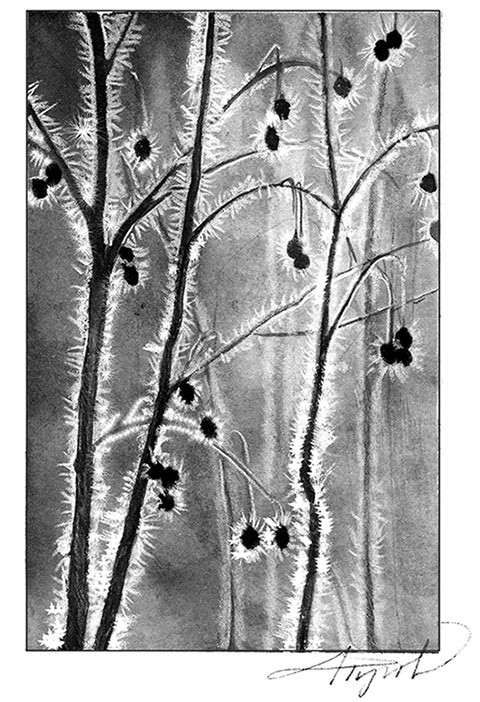
In folklore and literature, Jack Frost is often portrayed as a mischievous guy, sort of Old Man Winter’s younger self. He’s a personification of everything cold. In our region he’s a busy guy, at least for half of the year.
And an artistic one.
He gets credit for painting the trees orange and yellow and red in the fall. And we’re all familiar with ground frost, that harbinger of winter that looks like a dusting of snow. This phenomenon occurs when the temperature of objects near the ground falls below freezing. Water in the air freezes onto objects, sometimes as what looks like frozen dewdrops, sometimes as branched crystals.
Other times, Jack Frost picks up another brush to load everything with the lacy, feathery designs of hoarfrost.
Hoarfrost derives from the old English word “hoary,” meaning, getting on in age. It has the power to excite the poet in us. When you wake on a cold morning and look out to see the entire world — trees, bushes, your car — draped with lacy, feathery crystals glinting in the sunlight, it’s magical. The word “fairyland” comes to mind.
According to John Goff, the lead meteorologist at the National Weather Service Office in Burlington, hoarfrost is a “common occurrence” across the northern tier of the US, but almost nonexistent in areas with dryer, warmer climates. To form, hoarfrost requires a supersaturated column of cold air extending well above the surface of the ground.
Think a cold fog. Moisture in the air starts condensing around nuclei — particles of dust, for instance. Once that starts, the moisture in the air goes directly from a gas to a solid. It’s a process called sublimation, with ice crystals building up on everything, said Goff.
Hoarfrost appears as intricate, delicate and ephemeral crystal decorations. Jack Frost at his finest. These crystals reflect light from all their surfaces and thus look white. When the morning sunlight hits it...Wonderland.
Hoarfrost has one other requirement for formation: calm air conditions. It’s the calm air that allows those complex lacy depositions, said Goff.
That makes it different from rime ice, which also occurs on trees and structures.
Rime, said Goff, forms when “you have super cold water vapor.” With rime the liquid water in the air essentially freezes into crystals on surfaces, building up and up and up. Unlike hoarfrost, rime forms when it’s windy, and its sideways formations often reflect that.
In the eastern US, rime is most common at elevations from 3,000 to 7,000 feet, said Goff, where you can get a fog bank (aka a cloud), very cold temperatures, and high winds. The fog droplets freeze quickly, producing much smaller crystals than, say, freezing raindrops.
The crystals build up on the windward side of objects, building a somewhat spongy, porous layer of heavy ice.
You can find impressive rime sculptures on the summits of the Appalachians from Mt. Mitchell in North Carolina through the Great Smokies to northern New England’s Mt. Mansfield and the Presidential Range.
Rime gets credit, along with fierce winds, for pruning subalpine and alpine trees on New England’s high peaks into krummholz, a German word meaning crooked wood. It can also form on aircraft. In this scenario, instead of super cold, moisture-laden winds depositing rime onto stationary objects, a jet flies at hundreds of miles an hour into a supercooled, moisture-laden cloud. Planes can pick up a lot of ice that way and it can affect their lift.
Rime ice is also common “on sea-faring vessels in northern oceans around the world,” said Goff. The ice can weigh down ships and prove hazardous to navigation. It’s not “water vapor freezing out of the air though,” he said. “It's freezing ocean spray, of course. Nonetheless it's still rime.”
But hoarfrost? Well, even if you’re not a fan of winter, it’s hard not to be impressed. People like posting hoarfrost photos to social media.
Meteorologists, however, don’t give it as much thought. “In the world of weather it’s a non-impactful event,” said Goff. “It’s more of a gee-whiz type of thing.”


Discussion *